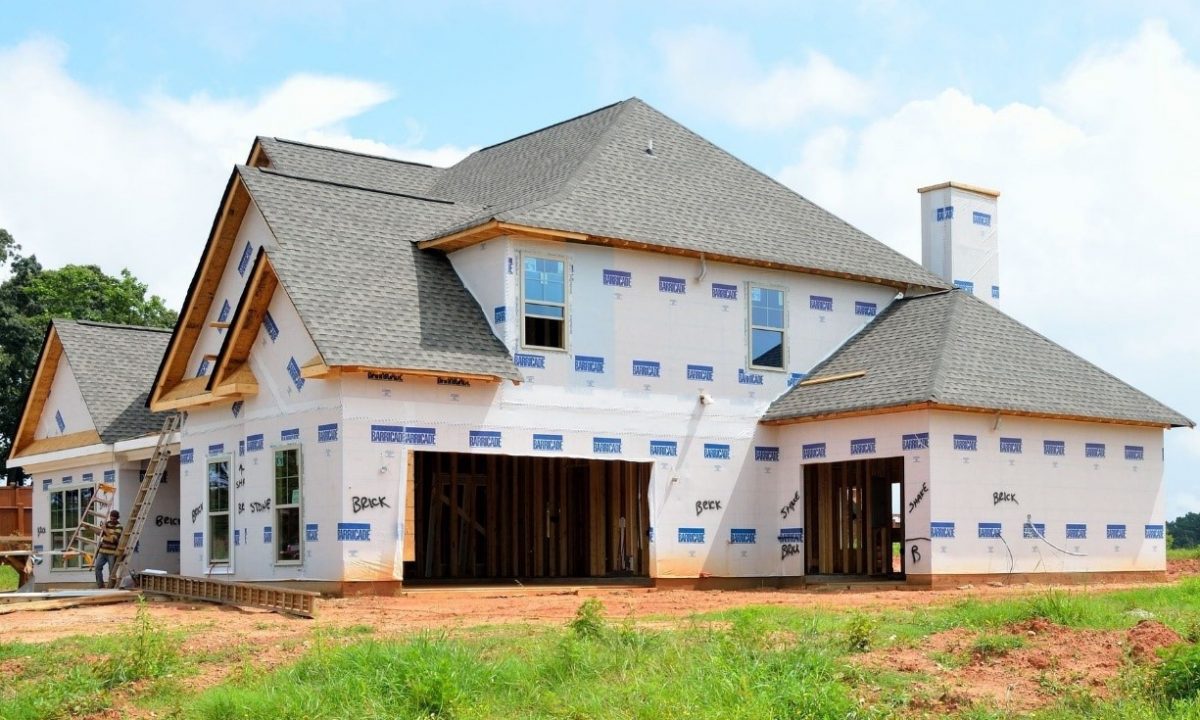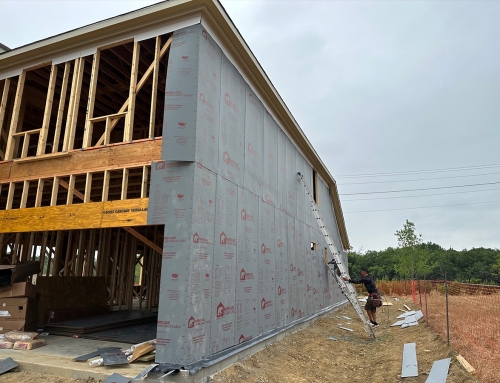House wrap, along with properly installed insulation, are essential elements for successful application of continuous insulation. Continuous insulation is crucial for creating a tight building envelope. The purpose of continuous insulation is to reduce air and moisture infiltration, stop thermal bridging, and increase the effective R-value in a wall assembly. The ASHRAE Standard 90.1-2013 defines continuous insulation as insulation that is uncompressed and continuous across every structural member without thermal bridges other than service openings and fasteners. In fact, the 2015 IECC and the ASHRAE 90.1 require continuous insulation in both commercial and residential structures. The standard specifies the amount of insulation needed (based on the building’s climate zone) to reduce air and moisture infiltration, stop thermal bridging, and increase the effective R-value in a wall assembly.
The 2015 IECC also mandates air leakage testing of a building envelope by either ASTM E 779 or ASTM E 1827. A tight building envelope is crucial to creating an energy-efficient and healthy building or home. House wrap, along with properly installed insulation are both critical to achieving continuous insulation.
WHAT IS CONTINUOUS INSULATION?
Continuous insulation in exterior walls is a vital and required design element of energy-efficient buildings and homes. The goal of continuous insulation is to curtail unwanted air leakage. Air leakage in a structure is the uncontrolled flow of air through gaps and cracks in the building’s envelope. Air infiltration allows musty air out and fresh air in, and is an important part of a healthy indoor environment. However, unwanted air infiltration can hinder the controlled airflow patterns and change the temperature and humidity conditions within a building.
Air infiltration commonly occurs around thermal bridges, door and window frames, attics, electrical outlets, fireplaces, dryer vents, and chimneys. Uncontrolled air infiltration lowers the effective R-value of the wall assembly and reduces the air quality and energy efficiency of a building. Continuous insulation is essential to limiting air leakage in a building or home.
THE BENEFITS OF CONTINUOUS INSULATION
Application of continuous insulation across all structural members of a building along with a moisture and air barrier, like house wrap, creates a tight building envelope. A structure with a well-sealed building envelope saves building owners money by first requiring a smaller HVAC system and then achieving lower monthly energy bills. Applying continuous insulation also improves the comfort level for the occupants through reduced drafts and outdoor noise. Furthermore, continuous insulation, along with house wrap, creates a healthy indoor environment by preventing a build-up of mold and fungi in the wall assembly. Achieving continuous insulation through proper installation of insulation and house wrap creates an energy-efficient, healthy, and quiet building or home.

WHY CONTINUOUS INSULATION NEEDS A HOUSE WRAP (AIR AND MOISTURE BARRIER)?
Continuous insulation applied across every structural member of a building or home limits unwanted air leakage, which saves building and homeowners energy and money. However, continuous insulation can inhibit a wall’s ability to release trapped moisture in the wall assembly. High moisture within a wall assembly is problematic because moisture can cause wood rot and costly repairs.
High moisture can also cause mold, which is unhealthy to the occupants of the building or home. Utilizing an air and water barrier, like house wrap along with continuous insulation, ensures that moisture that gets inside the wall will dry or escape to the outside. To stop decay and the growth of mold within a wall assembly, the design of a high-performing building or home must include an air and moisture barrier, like Barricade house wrap.
HOW BARRICADE HOUSE WRAP HELPS BUILDERS ACHIEVE CONTINUOUS INSULATION
Barricade® Building Wraps are high-quality moisture and air barriers that contribute toward achieving continuous insulation when combined with properly installed insulation. Barricade Building Wraps are water resistant and pass all the tests used to measure a house wrap’s water resistance: ASTM D779 (boat test), CCMC 07102 (pond test), and AATCC Test Method 127. Barricade Building Wraps have a high level of air resistance and are in accordance with IRC Section N1102.4.1 and IECC Section 402.4 and 502.4.
Barricade Building Wraps are also permeable to vapor. In fact, the ASTM E96 standard mandates house wrap with five perms or higher. The bigger the number, the more permeable the material. All five of Barricade’s house wraps achieve greater than five perms.
- Barricade® Building Wrap – Permeability (ASTM E-96A): 11 perms
- Barricade® Plus™ House Wrap – Permeability (ASTM E-96A): 16 perms
- R-Wrap® Protective House Wrap – Permeability (ASTM E-96A): 50 perms
Barricade Building Wraps, applied over insulation, achieve continuous insulation. Continuous insulation is essential for creating a tight building envelope. A tight building envelope creates an energy-efficient, healthy, and quiet home or building. Visit Barricade for more information on how Barricade Building Wraps can tackle continuous insulation.
A thermal bridge allows heat and energy to flow through it at a higher rate than the surrounding space; which lessens the effective R-value of the wall assembly. Thermal bridging typically occurs near highly conductive materials like wood studs, metal studs, steel, and concrete.
The R-value is a measure of conductivity thermal resistance.The effective R-value includes all the materials used in its construction: the studs, drywall, insulation, plywood, siding, etc. The higher the R-value, the better the thermal performance of the system or material.
The ASTM E 779 test method quantifies the air-tightness of a building’s envelope utilizing fan pressurization. The ASTM E 1827 test method quantifies the air-tightness of a building’s envelope utilizing an orifice blower door.







